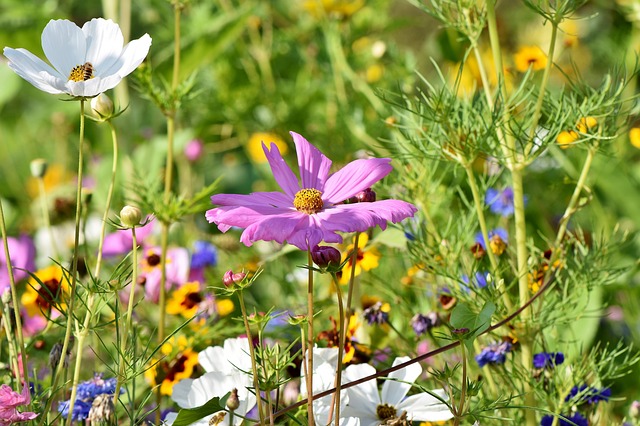
How to Grow Cosmos from Seed Indoors? 7 Simple Steps and Tips
Welcome to a world of beauty and elegance with cosmos flowers! Cosmos, with its vibrant colors and delicate petals, is a wonderful addition to any garden or indoor space. If you’re looking to add a touch of natural charm to your living space, you can grow cosmos from seed indoors which is super easy.
Not only is it a fun activity, but it also offers you the chance to bring a little bit of the outdoors into your home. In this blog post, we’ll guide you through the steps to successfully grow cosmos from seed indoors, so let’s dive into this!
Is It Possible to Grow Cosmos from Seed Indoors?
Yes, it is absolutely possible to grow cosmos from seed indoors! In fact, starting your cosmos seeds indoors is a great way to get a head start on the growing season and can also be an enjoyable indoor gardening project.
With a little bit of effort and patience, you can grow cosmos seedlings that are healthy and strong enough to be transplanted outdoors when the weather warms up.

How to Choose the Right Cosmos Seeds?
Choosing the right cosmos seeds is the first important step to ensure a successful indoor growing experience. You must keep these things in mind when selecting your cosmos seeds:
- Choose a reputable seed supplier: Look for a seed supplier with a good reputation for quality and variety. This will help ensure that you’re getting seeds that are fresh, viable, and have a high germination rate.
- Decide on the variety: Different varieties of cosmos are available in the market, so you have to decide which type of cosmos you want to grow based on factors such as color, size, and growth habits. Some popular varieties include Sensation Mix, Sonata Mix, and Purity.
- Check the seed packet: Read the seed packet carefully to make sure you’re getting the right type of cosmos and to check the germination rate and planting instructions.
- Look for organic or non-GMO seeds: If you’re concerned about the environmental impact of your gardening, consider choosing organic or non-GMO seeds.
- Consider the planting season: Choose cosmos seeds that are suitable for indoor planting and that will be ready to transplant outdoors at the appropriate time for your climate.
By keeping these factors in mind when choosing your cosmos seeds, you can ensure that you’re starting your indoor gardening project on the right foot.
When to Grow Cosmos from Seed Indoors?
The best time to grow cosmos from seed indoors depends on the climate in your region and when you plan to transplant the seedlings outdoors. In general, cosmos seeds can be started indoors 4 to 6 weeks before the last expected frost date in your area. Your cosmos seeds can be started indoors early to mid-March if your region generally experiences its last frost in late April. The best season to start the cosmos is Spring.
Please note that cosmos seeds are relatively hardy and can tolerate some cooler temperatures, but they will not thrive in extremely cold conditions. Therefore, it’s important to take the local climate and weather patterns into consideration when deciding when to start your cosmos seeds indoors.
What Climate Do Cosmos Grow Best In?
Cosmos is a warm-season annual flower that grows best in a climate with warm temperatures and full sun. They are relatively tolerant of heat and dry conditions but also grow well in mild climates with regular moisture. Cosmos can be grown in a wide range of USDA hardiness zones (from 2 to 11) and are adaptable to different soil types, from sandy to clay soils.
How to Grow Cosmos from Seed Indoors? Step-by-Step Guide
You can easily grow cosmos from seed indoors and it is fairly a simple and easy process. Cosmos are popular garden flowers that come in a variety of colors and can brighten up any space. Below is a step-by-step guide on how to grow cosmos from seed indoors:
What you may need to grow cosmos:
- Good quality cosmos seeds
- Seed-starting mix
- Seed-starting trays or pots
- Growing container
- Plastic wrap or a clear plastic cover
- Grow lights or a sunny windowsill
- Pure water and organic fertilizer
Follow These Steps to Grow Cosmos from Seeds Indoors:
-
Choose the Best container:
Cosmos plants can grow well in containers as long as the container is large enough and has proper drainage. Choose a container that is at least 12 inches deep and 12 inches wide. Cosmos plants have deep roots, so a shallow container will not provide enough room for the roots to grow. Make sure the container has drainage holes to prevent water from accumulating in the soil and causing root rot.
-
Prepare the Soil to Grow Cosmos:
Remove any weeds, rocks, and debris from the planting area. Weeds can compete with the cosmos plants for nutrients and water. Use a garden fork or tiller to loosen the soil to a depth of 8 to 10 inches. This will improve the soil’s drainage and aeration.
Cosmos plants prefer well-draining soil that is rich in organic matter. Add compost or well-rotted manure to the soil to improve its fertility and structure. The soil should be slightly acidic to neutral.
-
How to Sow Cosmos Seeds:
Start by filling the seed-starting trays or pots with a seed-starting mix. The mix should be moist but not soaking wet. Scatter the cosmos seeds over the soil surface. Do not cover them with soil because cosmos seeds need light to germinate. Cover the seed-starting trays or pots with plastic wrap or a clear plastic cover to create a humid environment. This will help the seeds germinate.

-
Growing Condition and Location:
Place the seed-starting trays or pots in a warm spot, preferably with temperatures around 70-75°F (21 to 24 degrees Celsius). You can use grow lights or place them on a sunny windowsill. Check the soil moisture regularly and water as needed. Do not overwater as this can lead to fungal diseases.
-
Cosmos Sunlight Requirement
Once the cosmos seeds germinate (it may take like 7 to 14 days) and seedlings appear, remove the plastic cover and move the trays or pots to a brighter spot. Make sure they receive at least 6 hours of direct sunlight or bright light each day.
-
Transplanting the Cosmos Plants
When the seedlings have grown their second set of leaves, it’s time to transplant them into individual pots or a larger container. You can also transplant them directly into your garden in case the weather is warm enough.
Harden off the seedlings before transplanting them outdoors. This means gradually exposing them to outdoor conditions, starting with a few hours of outdoor time each day and gradually increasing the time over a week or two.
-
Water the Cosmos Plants Regularly
Water the cosmos plants deeply once a week, providing enough water to thoroughly saturate the soil to a depth of 6 to 8 inches. Check the soil moisture regularly by inserting your finger into the soil. Water the cosmos plants in the morning to allow the foliage to dry before evening as it can help prevent fungal diseases.
That’s it! Following these simple steps will help you successfully grow cosmos from seed indoors and enjoy their beautiful flowers in your garden!
Cosmos Common Pests and Diseases
Yes, cosmos plants can be susceptible to pests and diseases. So to grow cosmos from seeds indoors, you must take care of the plant by keeping an eye on these common pests and diseases that may affect the plant:
Pests:
- Aphids – small, soft-bodied insects that can suck the sap from the leaves, causing distortion and stunted growth.
- Whiteflies – small, flying insects that feed on the underside of leaves, causing yellowing and wilting.
- Spider mites – tiny, spider-like pests that can cause stippling and webbing on the leaves.
Diseases caused by fungi:
- Powdery mildew – a fungal disease that appears as a white or gray powdery coating on the leaves, stems, and flowers.
- Botrytis blight – a fungal disease that causes gray mold to form on the flowers and leaves.
- Rust – a fungal disease that appears as orange or yellow spots on the leaves.
- Fusarium wilt – a fungal disease that causes the leaves to wilt and turn yellow, eventually killing the plant.
Diseases caused by phytoplasmas:
- Yellows – a disease caused by a phytoplasma that causes stunted growth and yellowing of the leaves.
Cosmos Disease Treatment: To prevent pests and diseases, it’s important to keep the plants healthy and stress-free by providing adequate water, nutrients, and sunlight.
You can also remove any infected plant parts and dispose of them properly to prevent the spread of the disease. Fungal diseases can be treated with fungicides, while insect pests can be controlled with insecticidal soap or neem oil.
Now You Can Grow Cosmos from Seed Indoors with Fun
In conclusion, growing cosmos from seed indoors is a simple and rewarding process that can bring beautiful blooms to your home or garden. By following the 7 steps and important tips described in this blog, you can ensure that your cosmos seeds have the best chance of germinating and thriving.
Remember to provide plenty of light, warmth, and moisture, and to transplant your seedlings into larger containers as they grow. With a little patience and care, you’ll soon be enjoying the vibrant colors and delicate beauty of cosmos flowers in your indoor or outdoor space. So go ahead, grab some seeds, and get growing!


